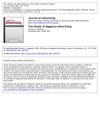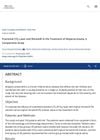Search
for
Sort by
Research
330-360 / 1000+ results
research Platelet-Rich Plasma in Androgenetic Alopecia: Is It Really Worth the Hype?
PRP therapy for hair loss is safe but its effectiveness is doubtful.

research The Shame of Magazine Advertising
Magazines should self-regulate and collaborate to stop deceptive ads and protect consumers.

research Acute Stroke After Scalp Injection of Platelet-Rich Plasma and Stem Cells for Hair Loss
A man had a stroke after getting a scalp injection for hair loss.

research Hair Disorders in Patients with Cancer
Cancer treatments often cause hair disorders, significantly affecting patients' quality of life, and better management methods are needed.

research Low Fluence-High Repetition Rate Diode Laser Hair Removal 12-Month Evaluation: Reducing Pain and Risks While Keeping Clinical Efficacy
A low-power, fast laser safely reduces hair with minimal pain and few side effects.
research Hair Growth by the Treatment of Various Alopecia Using Sequential Treatment, Platelet-Rich Plasma Injection, Followed by Mesotherapy
The treatment promoted hair growth safely and effectively.

research Fractional CO2 Laser and Minoxidil in the Treatment of Alopecia Areata: A Comparative Study
Combining fractional CO2 laser with minoxidil is more effective for hair growth in alopecia areata than minoxidil alone.

research TRPV3 Ion Channel: From Gene to Pharmacology
The TRPV3 ion channel is important for skin and hair health and could be a target for treating skin conditions.

research Dutasteride
Dutasteride effectively treats enlarged prostate, reduces prostate cancer risk, and promotes hair regrowth with few side effects.

research Telogen Effluvium Following Bivalent Human Papillomavirus Vaccine Administration: A Report of Two Cases
The HPV vaccine may be linked to temporary hair loss in children, but the benefits outweigh the risks.

research Genetics of Diabetes in Childhood
Certain genes are linked to type 1 and type 2 diabetes in kids, and changes in these genes can also cause other diabetes-related conditions.

research Hair Growth-Promoting Effect of Recombinant Human Sonic Hedgehog Proteins
Sonic hedgehog proteins may help grow hair.
research Home-Use Microneedle in the Treatment of Pattern Hair Loss: Efficacy and Safety
Home-use microneedles with 5% minoxidil are safe and effective for hair growth.

research Applications of Ultrasound-Mediated Gene Delivery in Regenerative Medicine
Ultrasound can help deliver genes to cells to stimulate tissue regeneration and enhance hair growth, but more research is needed to perfect the method.

research Hair Loss in Children: Causes, Impact, and Management
Children's hair loss has many causes and requires careful diagnosis and personalized treatment, including emotional support.

research Sensitive Scalp: Does This Condition Exist? An Epidemiological Study
Nearly half of the French individuals surveyed reported having a sensitive scalp, more common in women, often linked to hair loss and symptoms like itching, and triggered by factors including shampoos and pollution.

research Hair Growth Promoting Activity of Cedrol Isolated from the Leaves of Platycladus Orientalis
Cedrol from Platycladus orientalis leaves may promote hair growth effectively, especially in female mice.

research T Cell–Mediated Acute Localized Exanthematous Pustulosis Caused by Finasteride
Finasteride caused a rare skin rash in a man, which improved after stopping the medication.

research Complications in Aesthetic Surgery
Esthetic surgery complications can include infections, nerve injury, and more; proper evaluation and technique help prevent them.

research Potential Synergistic Effects of Human Placental Extract and Minoxidil on Hair Growth-Promoting Activity in C57BL/6J Mice
Human placental extract and minoxidil together significantly promote hair growth.

research Pharmacological and Histochemical Screening for Hair Growth-Promoting Activity of Daucus Carota Herbal Gel
Carrot extract in gel form may help hair grow better.

research Systemic Steroids With or Without 2% Topical Minoxidil in the Treatment of Alopecia Areata
Steroids help hair regrowth, and minoxidil slows post-steroid hair loss, but effects are temporary.

research Fibroblast Growth Factors Stimulate Hair Growth Through Beta-Catenin and Shh Expression in C57BL/6 Mice
Certain growth factors can promote hair growth in mice by activating hair growth-related proteins.

research Defining Hair Follicles in the Age of Stem Cell Bioengineering
The study found that bioengineered hair follicles work when using cells from the same species but have issues when combining human and mouse cells.

research Hair Growth-Promoting Activity of Herbal Hair Gel Containing Brassica Oleracea Extracts
Cabbage extract in hair gel may promote hair growth and could help treat hair loss.

research Hair Loss After Rhytidectomy
A woman had temporary hair loss after a facelift, which improved on its own within a year.

research Efficacy of Betamethasone Valerate Foam Formulation in Comparison with Betamethasone Dipropionate Lotion in the Treatment of Mild-to-Moderate Alopecia Areata: A Multicenter, Prospective, Randomized, Controlled, Investigator-Blinded Trial
Betamethasone valerate foam is more effective and safe for treating mild-to-moderate alopecia areata than betamethasone dipropionate lotion.
research Transcriptome Profiling and Differential Gene Expression in Canine Microdissected Anagen and Telogen Hair Follicles and Interfollicular Epidermis
Different genes are active in dogs' hair growth and skin, similar to humans, which helps understand dog skin and hair diseases and can relate to human conditions.

research The Semiotics of Breast Cancer: Signs, Symptoms, and Sales
The paper concludes that breast cancer treatment involves complex interactions between medical symptoms, patient experiences, and commercial influences, requiring a holistic approach.